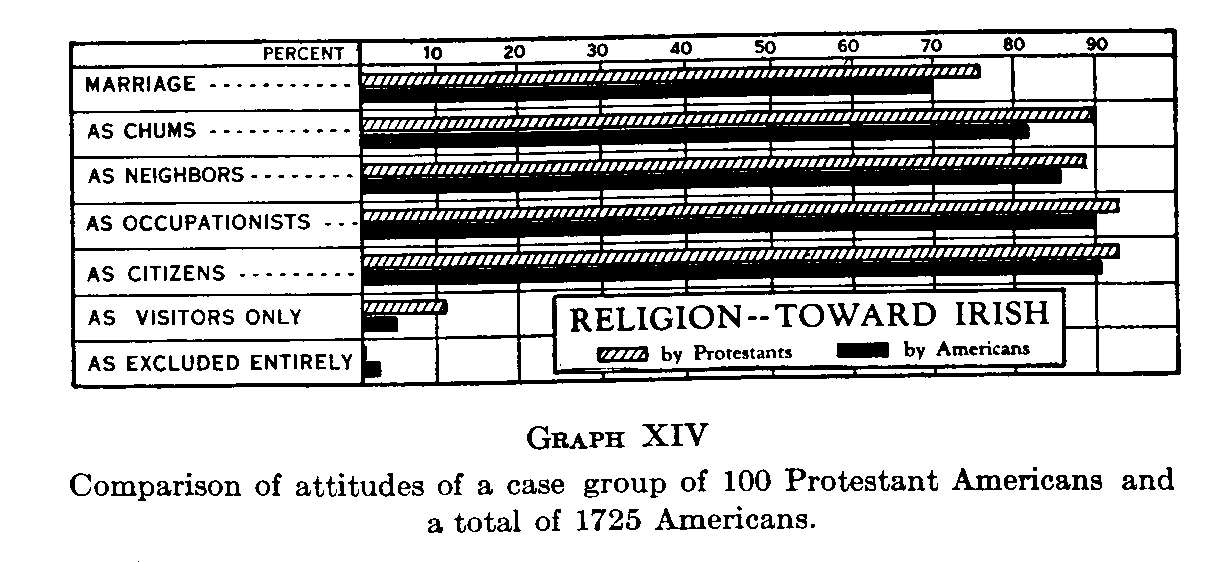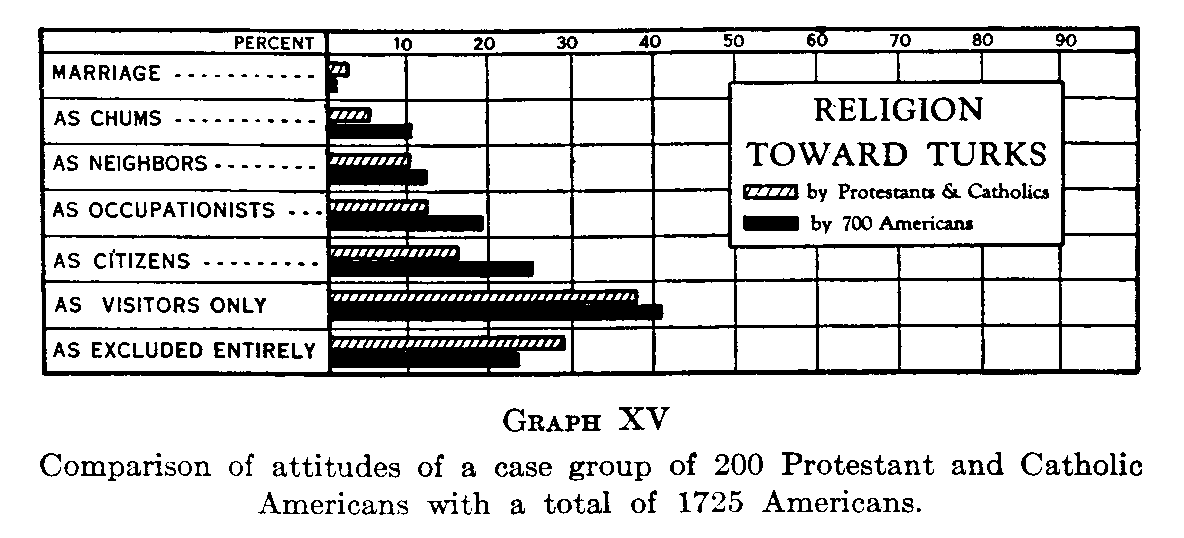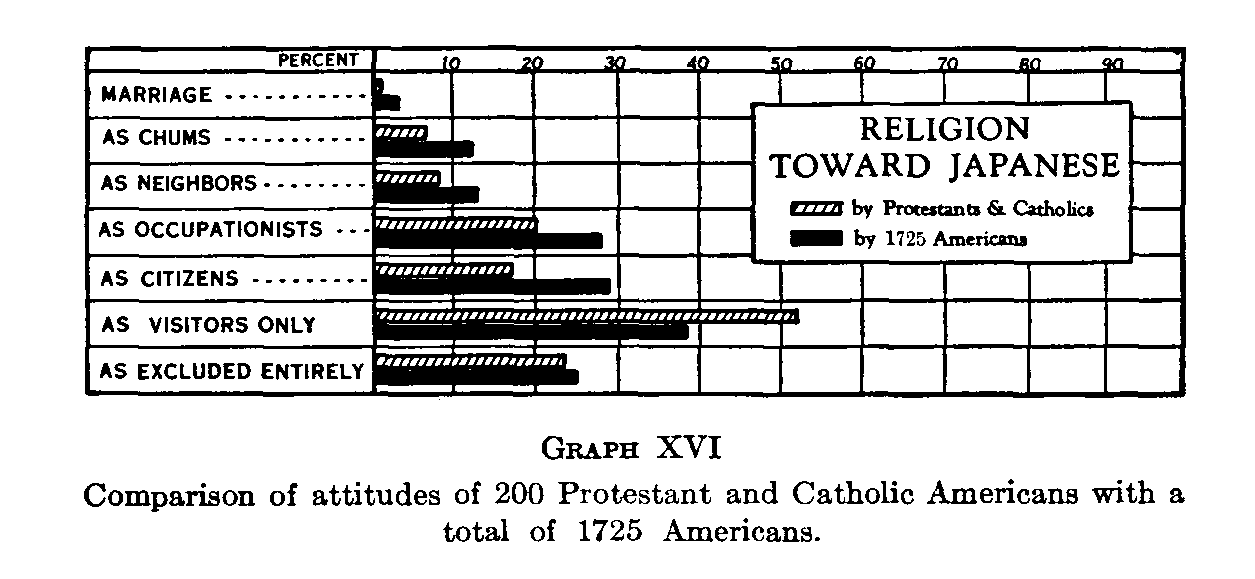Immigration and Race Attitudes
Chapter 16: Religious Differences
Emory S. Bogardus
Table of Contents | Next | Previous
When the racial attitudes of people are compared according to their religious divisions, differences are evident, but these are not as extensive as might be expected. Among 1725 Americans whose racial attitudes have been studied the larger religious divisions are represented —Protestant, Catholic, Christian Science, Jewish. Moreover, a large percentage or approximately one-half of the total number profess no religious connections.
Specific Distinctions. — In studying the racial attitudes, for instance, of the Protestants and Catholics as case groups, we observe that the former are as racially friendly as the

latter toward the French (Catholic). Similarly, the Catholic group is almost as friendly as is the Protestant group toward the English (Protestant). Graph XIV visualizes the similarity in the racial relations of 1725 Americans and of a case group of the first 100 Protestants of the 1725, whose racial attitudes toward the Irish (Catholics) were studied.
(210)
Personal interview materials secured from the case group afford explanatory data. The questions raised by a Protestant regarding a Frenchman, or by a Catholic concerning an Englishman, usually are, in effect: " What kind of a person is he? " " Is he reliable? " " Can he be trusted? " Outside of certain situations involving church competition, the world plans of the pope, or the special Ku Klux Klan activities, the question of religion ordinarily takes a secondary place, or else it is counterbalanced by other factors. There are, however, some persons who, for instance, have a strong anti-Catholic or anti-Protestant complex and who raise the religious question first and the personality question second.
The large numbers of persons who profess no religion make few distinctions regarding the religious beliefs of different races. They do not seem to care about what a man believes so much as what he does and how he behaves in social situations. They have strong prejudices against religious zealots of any race.
When a case group of the first 200 Protestants and Catholics (equally distributed) are taken from the 1725 Americans and their racial reactions are compared with the reactions of the 1725, the results do not show outstanding distinctions. The 1725 Americans are about as friendly (or as antipathetic) to Negroes, for instance, as are the Protestant and Catholic Christians taken as a single group. Surprising as it may appear, religious attitudes do not play the rôle that might be anticipated, or else they are neutralized. Religious attitudes seem to be often dominated by other factors. Life history materials indicate that the profession of religion by many persons is largely " opinion " rather than " attitude." When the test comes, no one in the South and few if any persons in the better " white " neighborhoods of the North want a Negro family " to move in next door." " Property depreciates." " Other Negroes will
(211) come in." " I'll have to move out." These are responses given by both Christians and non-Christians alike. Certain social and economic factors (environmental) often constitute pressures that dominate religious motivation. Much of the religious feeling of brotherhood and of Christian duty operates better at a distance than it does with reference to " undesirable next-door neighbors."
Religious Antipathies. —In regard to attitudes toward Turks, the reactions of the group of 200 Protestants and Catholics are on the whole less friendly than the reactions of the 1725 Americans (Graph XV). The persecutions of

<insert 15>
the Christian Armenians by the Mohammedan Turks have influenced American Christians to fear all Turks. They have quite naturally become less socialized (and less Christian) than non-Christians in their attitudes toward the Turks.
Moreover, there are many Christians to whom the term " Turk " visualizes " Mohammedan," the enemy of Christianity. Mohammedanism is thought of as a bloody religion determined to make its way to world domination by the sword. Hence, to such Christians, the Turk is symbolic of a religious movement that is a powerful competitor. The Christian fears a loss of status for his religion whenever in person or in image the Turk appears.
( 212)
On the other hand, there are Americans, mostly nonChristians, to whom the Turk does not stand as a religious competitor at all. He is viewed merely as a member of another race and hence less antagonistically than if considered as a competitor. There are some American nonChristians who through travel or otherwise have come to think highly of Turks. They prefer them to Armenians and Greeks. Such persons lower the average antipathy rating given the Turk by the 1725 Americans.
Again, there are less friendly reactions expressed toward the Japanese by the group of Protestants and Catholics than by the total group of Americans (Graph XVI). The life

histories show that many Christians, while professing race friendliness, waver when it comes to viewing the Japanese as citizens of the United States, as neighbors on the same street, and so forth. Some declare that " the Japanese immigrant is a Buddhist," and as such must be kept at a distance at all costs, even of religious profession. The Japanese is viewed as a religious competitor by many Christians and thus is placed at a greater social distance than by nonChristian Americans.
Many of the latter type of Americans raise no objection to the Japanese as Buddhists. Some even think that Bud-
( 213) -dhism would make a better religion for America than Christianity, and hence do not react on religious grounds against the Japanese as do Christians.
Religious Conflicts. —Persons of Christian beliefs, particularly Christian leaders, are making strenuous efforts to overcome the racial prejudices that are felt and expressed within Christian ranks. But even when they do their best, the problem bobs up.
122. I am a Christian leader, member of a church, and trying to live the teachings of Christ, but I don't want a big, burly Negro to sit down beside me in a street car or even in church. I feel like getting up and moving, even if I know that I ought not to. Ashamed, yes, but I'd rather contribute to social work among the Negroes than to do it myself. When the members of my boys' club ask me if I would want Negroes for neighbors, I blurt out, " No," and then hasten to explain that I wouldn't mind, but it is other people who compel me to protest. Not long ago it was reported that a Negro family was moving in, and I secretly gave aid to those protesting, although I did not sign the petition. I explained how my position would not permit me to sign. And yet I am a Christian, from northern Ohio.[1]
123. A group of six colored Hi-Y fellows from the N. Branch of the Y. M. C. A. attended the Hi-Y Camp at C. They were six out of one hundred ten boys. All the others were white. In trying to break the isolation, the camp director placed the Negroes around with the other white fellows in the various tents. On the surface, everything was all right, but underneath everything was wrong. These colored boys were socially isolated at the camp. Every white boy tried to make the colored boys feel as one of them, but it was impossible. There was a barrier that couldn't be broken down [2]
The wide differences in point of view of persons of various religious faiths is repeatedly indicated when our race attitude data are studied comparatively. Every religion has narrow-minded racial bigots; likewise each has world-minded spokesmen. Statements from a cosmopolitan Christian and a Buddhist illustrate the latter point well.
(214)
124. As an immigrant I have seen several religions in operation in different countries. As a soldier in the World War, I have seen three or four religions tested out. As an adopted citizen of the United States, I would like to see Christianity win out, but let people of all religions come, even Buddhists, Mohammedans, and the rest, and let all have a fair show. My childhood days were spent in a Congregational home, and I believe that Congregationalism will ultimately become the world religion — at least, deep in my heart, I hope so.[3]
125. Individuals differ in every aspect. There must be as much difference in religion as in individuals, to suit their minds. I do not believe that there is only one religion which is perfect and best. The truth is one, but the way to attain the truth is not a single path.
The thing I want to mention here is that I often meet persons who firmly believe that Christianity is the only right religion. They consider the persons who are not Christians as wrong beings. They show an antagonistic attitude to the non-Christian groups. I know this is not the world ideal of religious freedom. No broadminded people accept one religion for all, but, in fact, I do not meet such persons in Christian people, who are very narrowminded. I am sure there are just as narrow-minded persons in the Buddhist groups also, and I believe this is the greatest weakness of us —to feel the superiority of our own group.[4]
Racial attitudes when coupled with religion vary according to the degree to which a person's religion faces competition. Even a religion founded on broad race principles becomes exceedingly narrow and intolerant when its back is against a wall. As a person's religious attitudes sometimes shift according to the fight which he is making for social status, so his racial attitudes likewise respond. The fight for status may overrule religious ideals and even destroy racial tolerance.PROJECTS
1. Study the life history of a selected person, and analyze all the relations of religious factors to racial attitudes.
2. Compare religious factors with (a) occupational and (b) with regional factors in their influence oil racial attitudes.
( 215)
3. Compare the conditions under which religious attitudes are coupled with narrow racial attitudes, with conditions when religion and broad racial attitudes are found together.
4. Analyze carefully and compare the experiences of two persons where race attitudes are contrary to religious principles that are professed.
5. Compare three or more well-known religions, with reference to both favorable and unfavorable racial attitudes that have been carried into action by the representatives of each during the past centuries.
RELIGIOUS DIFFERENCES
BABCOCK, K. C., The Scandinavian Element in the United States, Chap. IX. University of Illinois, 1914.
DAVIS, JEROME, editor, Christianity and Social Adventuring, pp.319-331. Century, 1927.
PRICE, M. T., Christian Missions and Oriental Civilizations, Chap.I. Shanghai, 1924.
REUTER, E. B., The American Race Problem, Chap. XIII. Crowell, 1927.
SPEEK, R. A., A Stake in the Land, Chap. X. Harper, 1921.
STEINER, E. A., Against the Current, Chaps. XVIII, XIX, XXIII, XXV. Revell, 1910.
——, Nationalizing America, Chap. VIII. Revell, 1916.
——, On the Trail of the Immigrant, Chap. XXII. Revell, 1906.